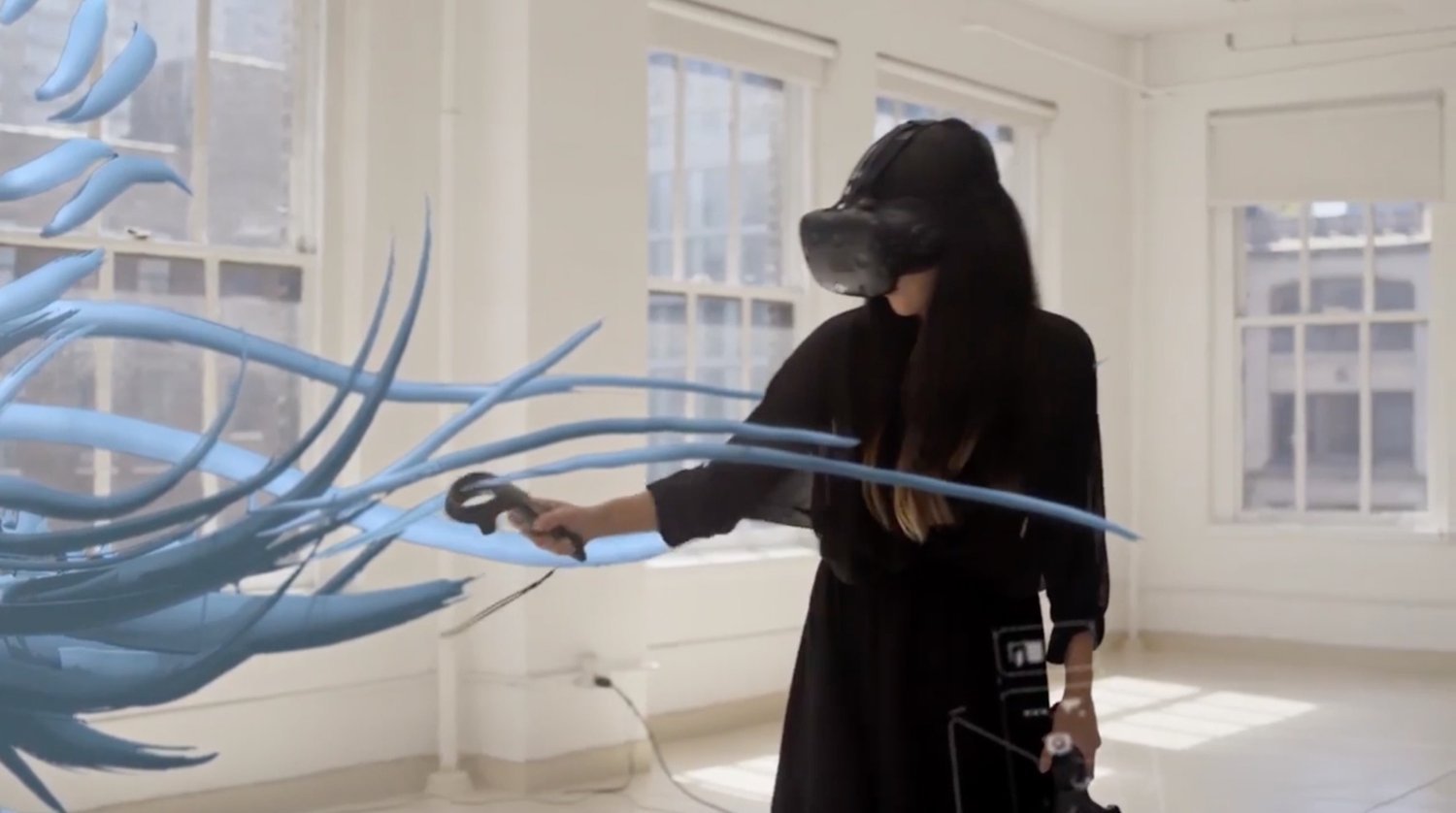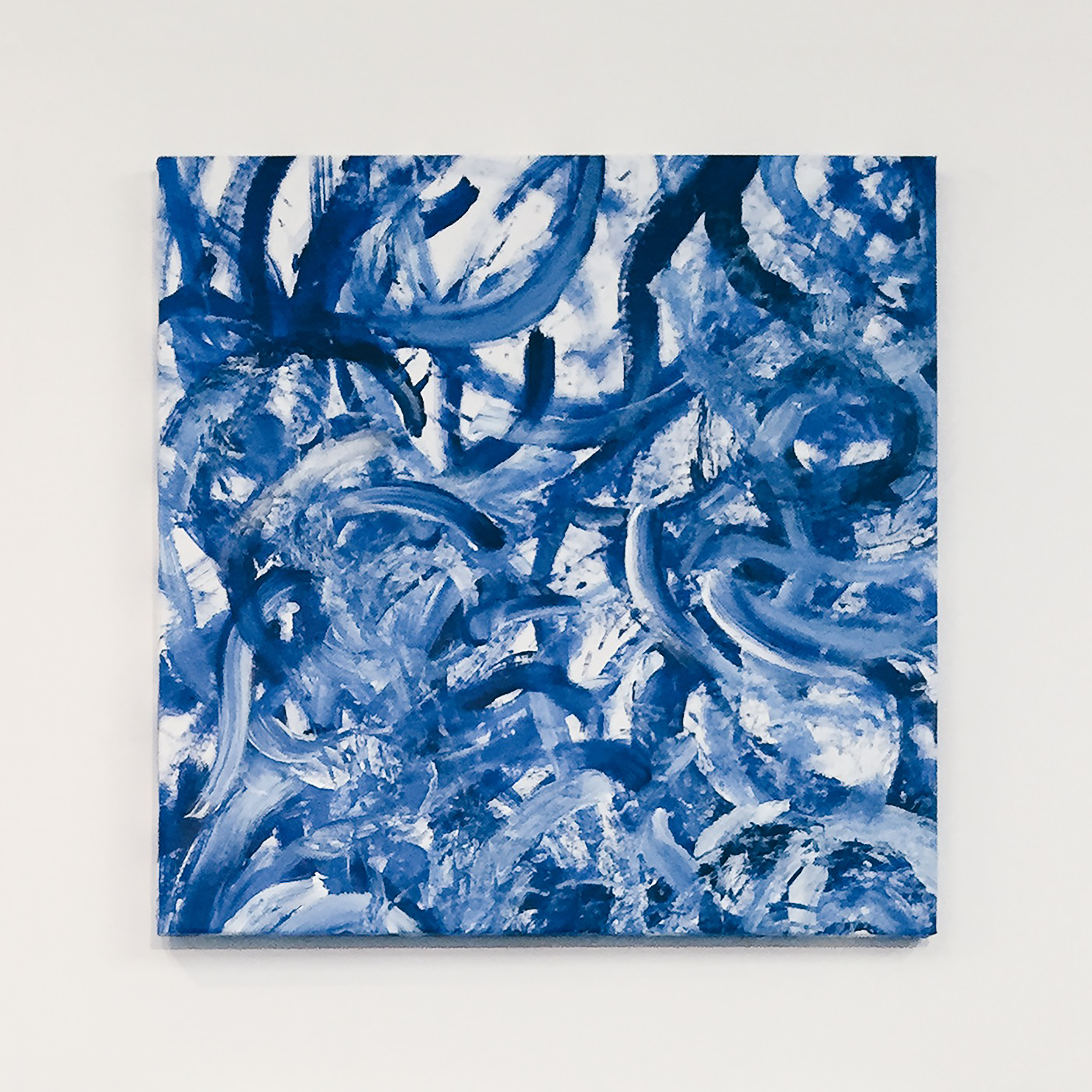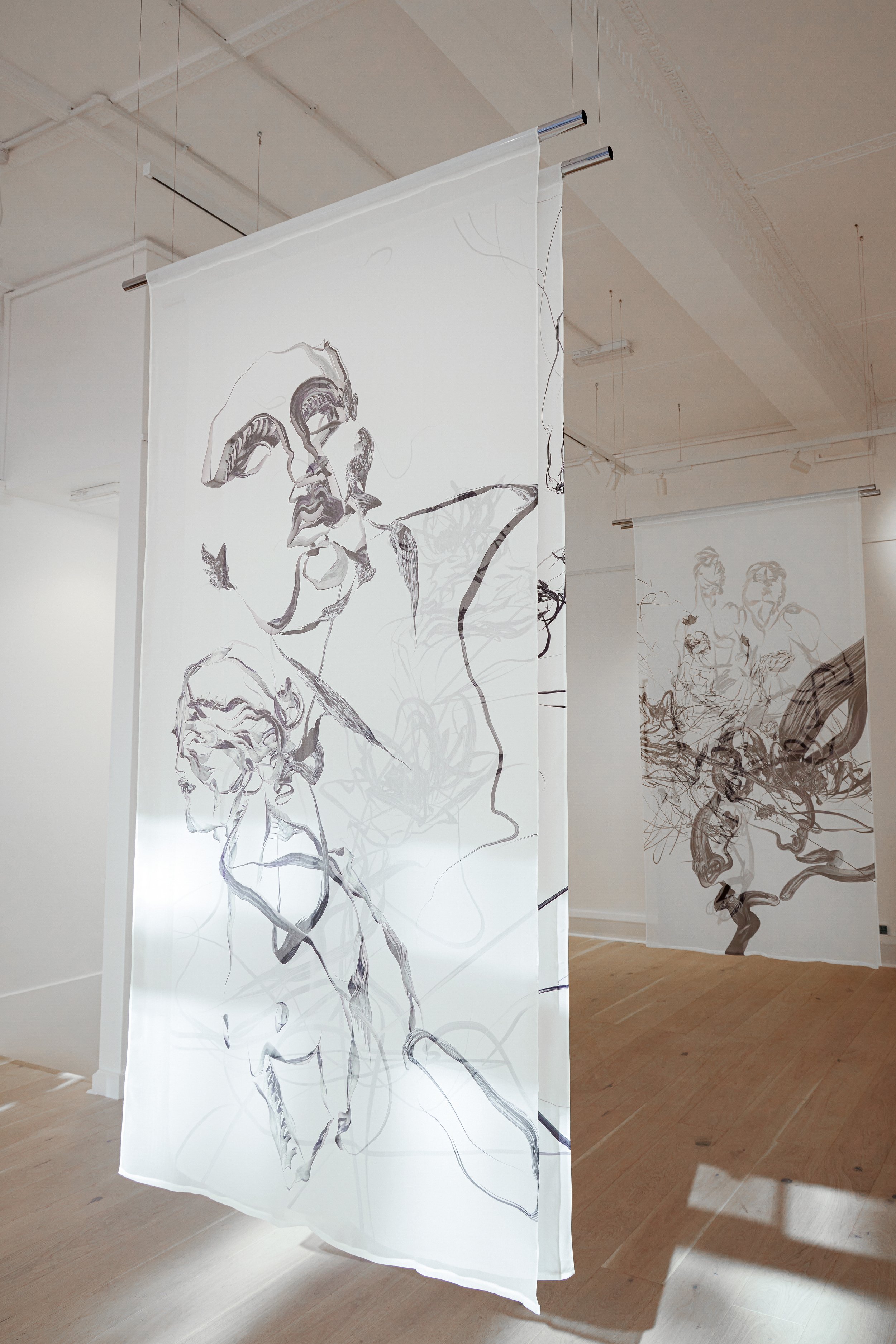SOUGWEN CHUNG: COLLABORATING WITH TECHNOLOGY
Nowadays there’s plenty of art made by machines – raising the matter of whether that can indeed count as art – as well as by humans. Yet the Chinese-Canadian artist and researcher Sougwen Chung, a former research fellow at MIT’s Media Lab and artist-in-residence with Nokia Bell Labs, is unusual in combining those categories: she has found novel ways not just to work with robots and computers, but to collaborate with them as partners. And, for all the cutting edge technology of her processes, the results fit very easily into the traditional aesthetics of physical art. Her paintings, drawings and prints don’t look quite ‘normal’, but you would be hard-pressed to guess how they are made without seeing Chung in performance or on film.
She works across different methods, collaborating with bespoke robotic systems so that human and artificial arms work together to make a work directly, and with processes of drawing in simulated environments – using Virtual Reality headsets to create the data which is then transformed into an artwork.
As for what led her in this unusual direction, Chung explains that ‘my background in the sciences and art has always been entangled. I have my family lineage to thank for this. My mother was a programmer and my father an opera singer, so I grew up with computers and music and felt a natural affinity towards both. I think I coded my first website when I was 9 or 10.’
‘I was classically trained in violin, which may be where I first developed my intuition in the gestural, abstract and expressive movement in collaboration with instruments, tools, and – more broadly speaking – creativity.’ Music and computers, then, first drew her into the combination of science with art. ‘The expressive abstract form of sound and instrumentation, the generative beauty of music theory, and the structure of code and screen-based work made a lot of sense to my brain’.
Over the years, Chung has built an international network which includes many scientists with whom she speaks frequently, ‘whether that’s on scientific topics, creativity or literature’. She has currently established her studio Scilicet in London, and she and her team are building various new collaborations.
How did she come to draw with robots and systems? Chung says the rise of automation across so many different industries led her to wonder: ‘If machines are starting to be able to do the work traditionally done by humans, what will become of the human hand? How does our desire for perfection, precision and automation affect our ability to be creative?’ That led her to explore questions about where AI ends and we begin, to develop ‘processes that investigate potential sensory mixes of the future’, seeing those as where philosophy and technology intersect.
Chung’s first collaboration with a machine was Drawing Operations Unit Generation – D.O.U.G. for short. With little knowledge of robots, she took some open-source robotic arm designs, and built a system where the robot would match her gestures, following in real time to mimic what she drew. That occurred in front of a live audience: she likes people to see how she and the robots paint together as an ‘embodied AI’, giving viewers a feel for how these systems can reflect our everyday lives, in memory and creative collaboration.
D.O.U.G didn’t exactly follow Chung’s movements. Rather, it would slip and slide and falter so that she had to respond, so that artist and machine were adapting to each other. Those ‘mistakes’ made the work more interesting, and Chung took that further for second generation of D.O.U.G: instead of an accident produced by pushing a robotic arm to its limits, she designed a system that would respond to her drawings in ways that she didn't expect. Chung used an algorithm to extract visual information from two decades of her drawing practice, and fed those back into the machine via custom software. The robot became a real-time interactive reflection of the work she’d done throughout her life, but when she made a mark she couldn’t predict exactly how the robot’s response would adjust it in light of the extensive personal data it would bring into play. For D.O.U.G._3 Chung developed 20 custom robots to work with her. She and her team collected video from publicly available camera feeds of all kinds of urban movement – people and traffic - and combined that with her inputs to yield a radical approach to what might be seen as landscape painting. D.O.U.G._4 is more intimately tied to Chung: it connects to her brain-wave data, and this influences how the robot behaves.
Chung continues to push in this direction, believing that by teaching machines how to do the work traditionally done by humans, we can expand the potential of both. The latest multi-robotic iteration, D.O.U.G._5, takes that further in the project Assembly Lines, currently on show in Finland. It begins with a live meditation that forms the basis of a 24 minute performance, showcasing an improvisational creativity between human and machine painting and drawing across three canvases. During the performance, D.O.U.G._5 responds to Chung’s biofeedback through the use of an E.E.G headset as she draws and meditates. In a sharp contrast with the established use of robotics as tools of automations in factory assembly lines, Chung’s Assembly Linesbecomes a ceremony of closeness and collaboration, between the biological and mechanical, performer and audience. The resulting paintings are on display alongside film of the performance at Espoo[i].
Chung has also developed quite different means of integrating technology into her creative processes, through creating artefacts in virtual reality spaces – as featured in her recent London show[ii].
‘Virtual Ink’ consisted of works entirely drawn in a simulated environment using a bespoke process over a Virtual Reality headset. As a medium, ‘the possibilities of drawing within a sculptural digital landscape add new spatial orientations to traditional approaches to painting.’ As she explains, ‘it’s not just about making new or novel tools. Drawing, for me, as an artist and researcher is about ritual. A line is a contour of a lived experience, and when you can evolve the nature of that line, you can change your nature. Like a kind of meditative awakening, reliant on the extent of your own imagination.’
What appeals to Chung is how ‘the drawn stroke takes on a dimensional and sculptural quality unlike those created with tangible and raw materials’, and that ‘by going beyond functionality, challenging material processes and stepping into new hybridities of making, you’re able to explore new creative possibilities. ‘Virtual Ink’ reflects these entangled synchronicities of the human collaborating with systems, and what is converted into the gallery space is captured as various drawing artefacts.’
One might expect an NFT to result, but, says Chung: ‘For me, it’s all physical. The virtual is just a different type of physicality, a designed tangibility perhaps. To me. Each physical artwork is a memory of the virtual, a capture of the moment of experience of the dimensional work’. Those artefacts are 2D images, even though every stroke of virtual ink is created in three dimensions. As Chung says ‘the work is made in thin air, and takes on a physicality only possible in digital space. In that way it becomes work that the viewer can move through, live and create a place for themselves within.’
So why not print in 3D? Chung believes that her virtual brushstrokes ‘are emboldened by the printed 2D format; offering frames into the sculptural quality of the lines within the virtual environment. The spaces between the lines, as they overlap, seem embossed from paper, offering space for the dimensions to be imagined. Viewers are encouraged to explore the space with the augmented reality experience that blends the layers between the gallery and digital experience of the artwork.’ Moreover, some of the images are printed onto silks hung from the ceiling, giving them an alternative spatiality and introducing an interaction with the viewer through how the images are rippled by the air currents caused by people passing by them. In Chung’s words, ‘a fluidity is placed over the imagined environment offering the printed artefact new and organic movements, exploring the possibilities of the digital and the physical as virtual ink.’
The images rendered in these ways use a neutral, restrained colour palette and initially look somewhat abstract, like the bulk of the robot-collaborative works – but soon cohere into figures and animals. Chung explains that the state of lockdown not only suits the more inward solo technique of this body of work, but also informed the subjects: ‘Over the last few years, as we all found a moment for pause and inquisition, I became interested in the entangled subjects of the individual and the environment, expressed in figures, animals and nature. During my studies of Chinese painting techniques, I’ve been engaged in the historical lineage of artists of their time using drawing to capture and ruminate on the relationships between these elements. I’m excited by the idea that these practices are rituals that are passed on through generations. You could say these drawings are part of a homage to those traditions, using the tools of today and tomorrow.’
Looking back across Chung’s work at the human – AI interface, one might consider what it tells us about our attitudes. Her art runs counter to sensationalist and adversarial fears about AI taking over humanity. Rather, the experience of working in partnership with machines and computers has taught Chung that ‘collaboration is the key to creating the space for both as we move forward’. And that has brought several things into focus: ‘how embracing imperfection can teach us something about ourselves; how exploring art can actually help shape the technology that shapes us; and how combining AI and robotics with traditional forms of creativity can help us think a little bit more deeply about what is human and what is the machine.’ Going beyond the conventional binary of ‘controlling / being controlled’ brings Chung to an optimistic view of the potential for collaboration. Moreover, Chung demonstrates that such a coming together can produce works which couldn’t be made by a human alone, and incorporate both her individual and our collective experiences of art and beyond.
For more on the artist and her work, please visit her website here.
[i] Sougwen Chung presented Assembly Lines, a new large scale kinetic multi-robotic installation and film, as a part of EMMA - Espoo Museum of Modern Art's exhibition 'In Search of the Present' until January 15th 2023
[ii] Virtual Ink was at Gillian Jason Gallery, London: 7 July – 13 Aug 2022
All images shown courtesy of the artist ©️ Sougwen Chung. All rights reserved.











